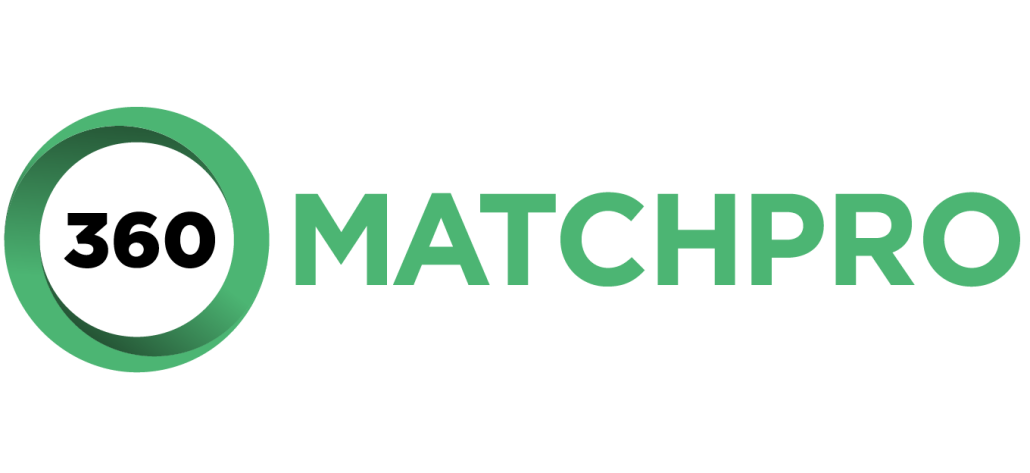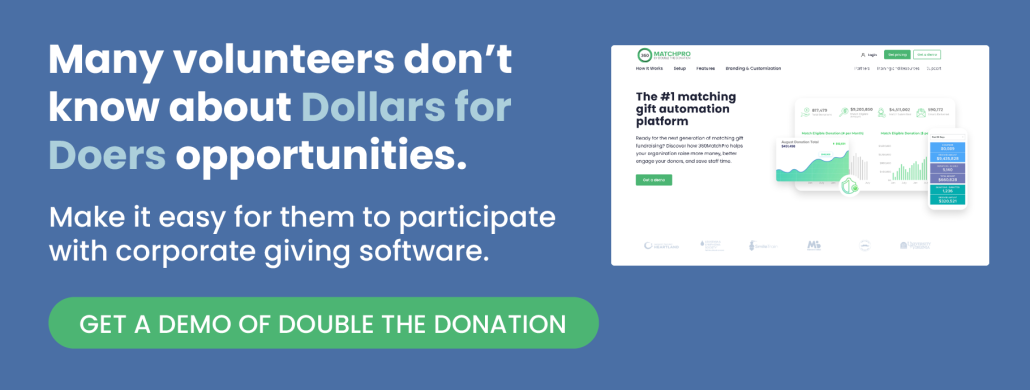Nonprofits are always looking for new revenue sources so they can properly support their beneficiaries. Additionally, many of them need a substantial base of volunteers to help them carry out their missions. What if there was a way to secure more funding and volunteers at the same time? Enter Dollars for Doers programs.
In short, Dollars for Doers programs incentivize employee volunteering and help nonprofits gain more for their causes. In this guide, we’ll cover everything you need to know about Dollars for Doers to make the most of the programs for your organization. This will include:
- What Are Dollars for Doers?
- How Do Dollars for Doers Programs Work?
- Dollars for Doers and Corporate Volunteerism Statistics
- Top Companies with Dollars for Doers Programs
- Why You Should Invest in Dollars for Doers Software
- How to Promote Dollars for Doers Opportunities
- 3 Organizations With Powerful Dollars for Doers Strategies
Whether you’re looking to refine your existing Dollars for Doers efforts or you’re hearing of the programs for the first time now, this article is for you. Now, let’s begin!
What Are Dollars for Doers?
Dollars for Doers falls under the umbrella of corporate giving. Companies with Dollars for Doers programs give monetary grants to the organizations their employees volunteer with.
If this type of corporate giving initiative sounds familiar to you, chances are you’ve heard it called by a different name. Some companies call their Dollars for Doers programs:
- Volunteer grant programs
- Matching time programs
- Dollar for hour programs
- Grants for time programs
While these programs can have a substantial impact on nonprofit revenue, many nonprofits and volunteers are unaware that these programs exist or that they’re eligible. As a result, nonprofits don’t properly promote these opportunities, and volunteers don’t know to look out for them. Currently, only 3% of eligible volunteers actually participate in the programs!
That’s why it’s important that nonprofits, volunteers, and businesses know how Dollars for Doers operate and how they can get involved.
How Do Dollars for Doers Programs Work?
No matter what a company calls its Dollars for Doers programs, most follow the same (or a similar) process. The steps include:
- An employee volunteers with their nonprofit of choice.
- The employee requests a Dollars for Doers grant from their employer.
- The employer reviews the request and the volunteer hours logged.
- If approved, the employer contributes to the nonprofit in accordance with their program policy.
What differentiates companies’ Dollars for Doers programs from each other are their policies. Each company has different guidelines regarding the following elements:
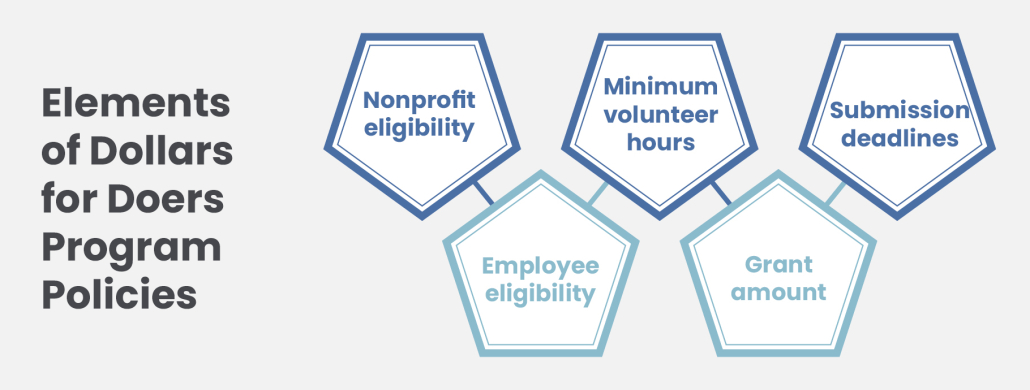
- Nonprofit eligibility. Companies can restrict the types of organizations that are eligible for their Dollars for Doers programs. For example, many require nonprofits to have registered 501(c)(3) status with the IRS. Businesses with certain core corporate social responsibility (CSR) values, such as sustainability and disaster relief, may only give Dollars for Doers grants to nonprofits with missions that align with those values. Lastly, companies sometimes exclude political or religious organizations from their volunteer grant programs.
- Employee eligibility. While some companies make all employees, past or present, eligible to participate in their Dollars for Doers program, others restrict their programs to only current and/or full-time employees. Meanwhile, some will include gifts made by the spouses or domestic partners of employees!
- Minimum volunteer hours. The minimum number of volunteer hours employees must log to activate a grant can vary greatly from company to company. While some companies contribute grants according to the number of hours donated, others opt to have employees reach a certain hours threshold and contribute a flat donation.
- Grant amount. Whether companies contribute to nonprofits based on volunteer hours or once employees pass a volunteer hour threshold, they need to determine a set grant amount. For companies that donate per hour their employees volunteer, 80% contribute between $8-$15 per volunteer hour.
- Submission deadlines. To ensure employees know when to submit their requests, companies set submission deadlines in their Dollars for Doers program policies. Some choose the end of the calendar year as their deadline while others pick a certain date that requests must be in by.
To ensure nonprofits reap the benefits of these programs, companies should promote their Dollars for Doers programs and guidelines to their employees. They should also make their requirements public so that nonprofits can encourage their volunteers to check their eligibility and submit requests.
Dollars for Doers and Corporate Volunteerism Statistics
With a clear understanding of how matching time programs work, you now may be wondering about their impact on nonprofits. We’ve compiled some statistics to show you the potential these initiatives have for immense nonprofit support:
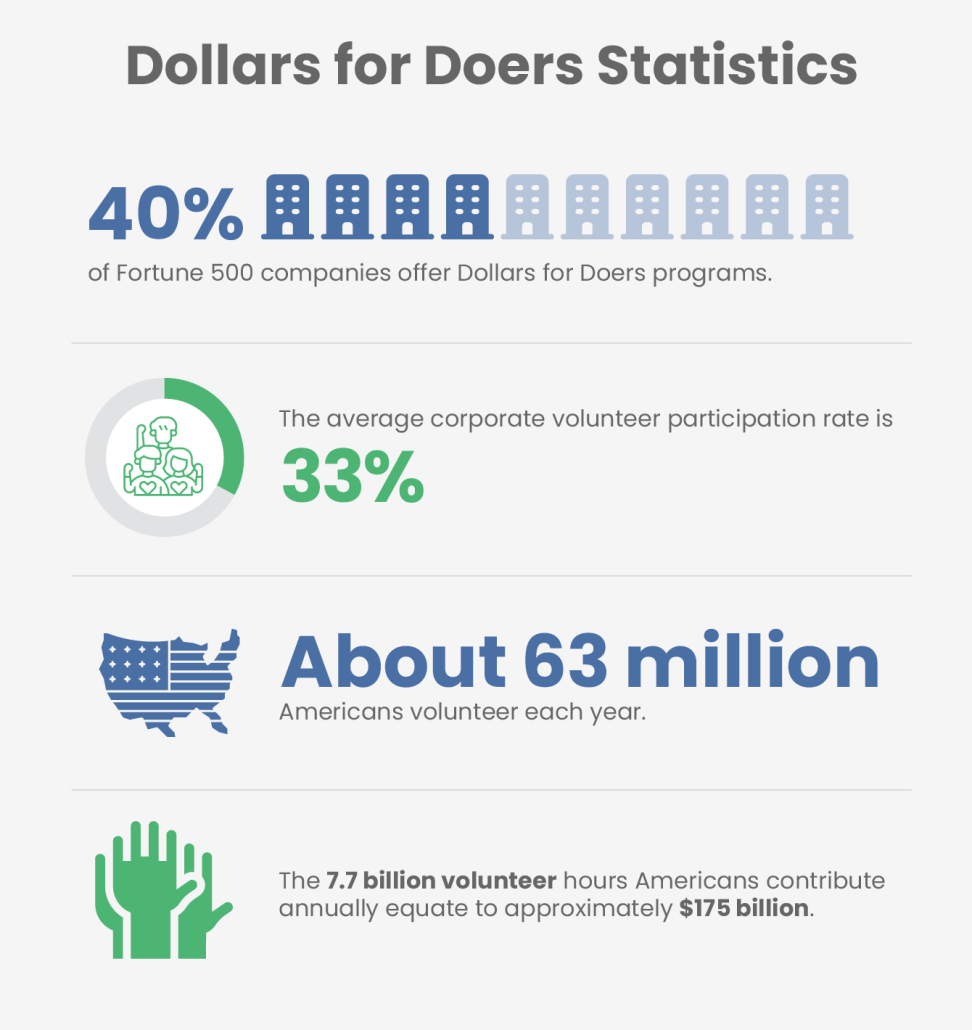
- 40% of Fortune 500 companies offer Dollars for Doers programs. This figure puts Dollars for Doers in second place for the most popular form of corporate giving, right behind matching gifts. These companies prioritize corporate giving that heavily involves their employees and allows them to amplify their positive impact on their favorite causes.
- The average corporate volunteer participation rate is 33%. With about a third of the workforce participating in corporate volunteer programs, there is massive potential for nonprofits to obtain more funding. All corporate volunteers have to do is check their eligibility for volunteer grants and submit a request to their employer.
- About 63 million Americans volunteer each year. This statistic indicates that it’s not getting people to volunteer that’s the issue; it’s spreading awareness about Dollars for Doers opportunities. Think about the potential revenue nonprofits could generate if each eligible volunteer participated in their company’s Dollars for Doers program.
It’s clear that Dollars for Doers programs offer benefits to nonprofits in both donation revenue and volunteer help. But what about companies? Why would they create these programs in the first place? These statistics illustrate the benefits of corporate volunteer programs and CSR in general:
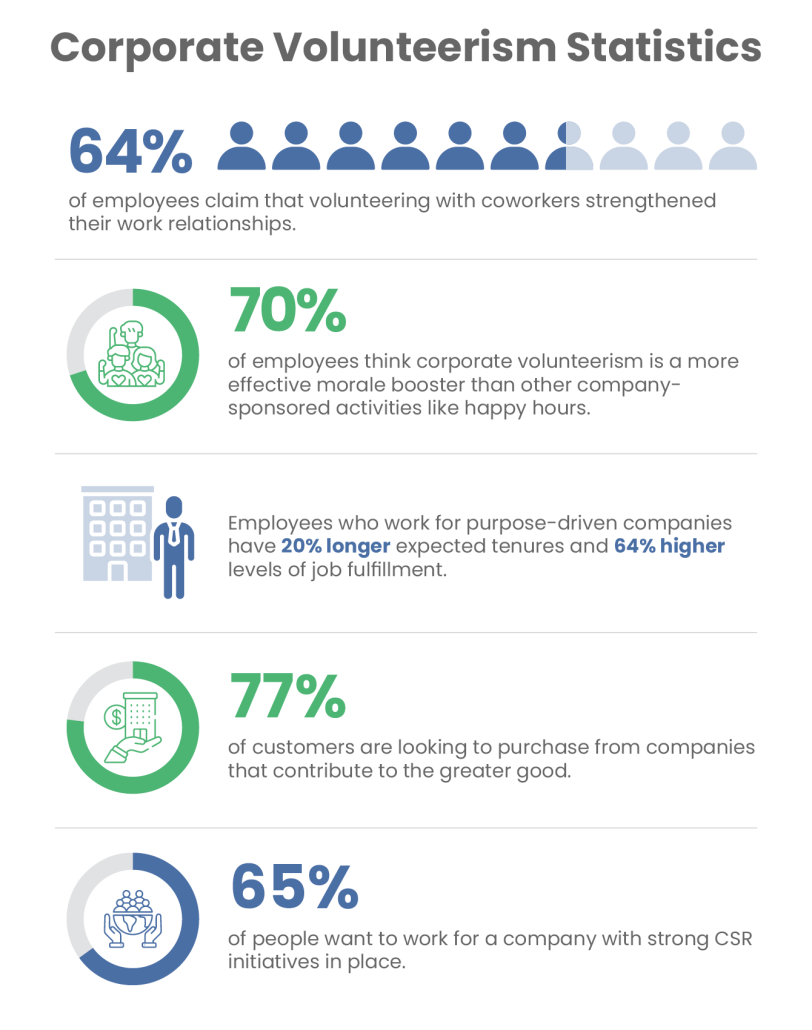
- 64% of employees claim that volunteering with coworkers has strengthened their work relationships. Team building activities outside the workplace strengthen work relationships and performance at work. Volunteering gives coworkers a common goal that they can conquer together, increasing team cohesion.
- Employees who work for purpose-driven companies have 20% longer expected tenures and 64% higher levels of job fulfillment. Employee retention is a major challenge for employers everywhere. Employees who work for purpose-driven companies feel empowered to not just complete their work but also make the world a better place while they do so. As a result, these employees are more likely to be committed to their jobs and stick around.
- 77% of customers look to purchase from companies that contribute to the greater good. It’s not enough these days to just sell a high-quality product or service. To appeal to consumers, companies need to prove they’re using their power and profits for social good.
As these corporate volunteerism trends show, Dollars for Doers programs benefit everyone involved, including nonprofits, companies, employee volunteers, and customers. As long as more companies create these programs and more nonprofits promote them, they can continue to provide value for all.
Top Companies with Dollars for Doers Programs
Want to know which companies support nonprofits through Dollars for Doers programs? Check out a few of the top companies that offer this incredible opportunity:
Apple
Through its Employee Giving program, Apple has raised over $880 million, and its employees have logged over 2 million volunteer hours.
In fact, Apple employees are such active volunteers that the company has formed special connections with charitable organizations. For example, so many Apple employees volunteer at one nonprofit that their care coordinator claims, “We now have Apple volunteers here almost every Friday — we call them Apple Fridays.”
Apple pairs its corporate volunteer efforts with donations. Through its Dollars for Doers program, Apple contributes $25 per volunteer hour logged to nonprofits. Apple’s program is especially accessible because they have no minimum hour requirement, allowing any employee who volunteers in any capacity to participate.
Apple employees can log their volunteer hours and request volunteer grants through Apple’s CSR platform.
Disney
The Disney VoluntEARS Grants program allows employees and cast members to request Dollars for Doers grants for the nonprofits they volunteer with. Since the program’s inception in 1983, Disney’s VoluntEARS have volunteered about 13 million hours. Additionally, Disney has contributed about $23 million in Dollars for Doers grants over the past decade.
Most of Disney’s volunteer efforts focus on helping kids in need. Whether that’s through packaging donated school supplies or knitting handmade blankets for children’s hospitals, Disney VoluntEARS are committed to equipping kids everywhere with the resources they need.
Once Disney VoluntEARS devote their time to their favorite causes, they can request an “EARS to You” grant for the nonprofits they volunteer with. Disney contributes a set grant to organizations depending on the number of hours a volunteer logs:
- 10-24 hours = $100 grant
- 25-49 hours = $250 grant
- 50-74 hours = $500 grant
- 75-149 hours = $1,000 grant
- 150+ hours = $2,000 grant
For especially committed volunteers, Disney presents “VoluntEARS of the Year” grants of $2,500 to the volunteers’ nonprofits of choice.
Microsoft
Microsoft proudly displays on its website that its employees volunteered 720,000 hours in 2022, which is equal to 82 years’ worth of time. The company also hosts its annual Giving Campaign in October to encourage corporate giving.
A unique aspect of Microsoft’s volunteer program is its pro bono services. For example, the Microsoft legal department and volunteers donate their time to help organizations such as Kids in Need of Defense and the Afghan Asylum Initiative. And Microsoft employees are given up to 30 hours each year they can spend volunteering during regular business hours while receiving their regular paycheck through the company’s VTO program, too!
In terms of Dollars for Doers, Microsoft contributes $25 per volunteer hour to eligible nonprofits with no minimum hour requirement. Like Apple, Microsoft uses a CSR platform where employees can log their volunteer hours and submit grant requests. Through corporate giving initiatives like Dollars for Doers, Microsoft employees contributed $255 million in 2022 to over 32,000 nonprofits.
Why You Should Invest in Dollars for Doers Software
Facilitating Dollars for Doers opportunities shouldn’t take up too much of your nonprofit team’s time. That’s why there are software solutions dedicated to helping charitable organizations maximize revenue from these programs and other similar corporate giving methods.
Investing in Dollars for Doers software allows your organization to:
- Raise awareness for Dollars for Doers opportunities. The biggest barrier to Dollars for Doers participation is a lack of awareness. The right software allows you to embed a corporate giving database into your website so volunteers can easily see if their employer offers volunteer grants. Then, they can submit a request!
- Earn more money for your cause. The more people that know about Dollars for Doers opportunities, the more you can raise for your cause. Plus, corporate giving platforms make it easy for volunteers to send request forms to their employer without ever leaving your website. As a result, you’ll have more Dollars for Doers grants seen to completion.
- Incentivize volunteers to continue lending their support. Volunteers will be thrilled to know that their time dedicated to your nonprofit can also be turned into donations for your cause. Keep volunteers coming back by allowing them to seamlessly submit Dollars for Doers requests and maximize their support for your nonprofit.
- Analyze key giving metrics. Once volunteers start using your Dollars for Doers platform, it will generate data you can implement into your fundraising approach. For example, you may notice that a large percentage of your volunteers work for IBM. This data may empower you to reach out to IBM, letting them know their employees are passionate about your cause and asking if there’s an opportunity for a more formal partnership.
Double the Donation Matching is the top Dollars for Doers platform. With over 24,000 companies represented, volunteers can easily find their employer, determine their Dollars for Doers eligibility, and send a request.
How to Promote Dollars for Doers Opportunities
Besides your software solution itself, there is a variety of other ways you can promote these opportunities to your volunteers. We recommend using a combination of the following methods:
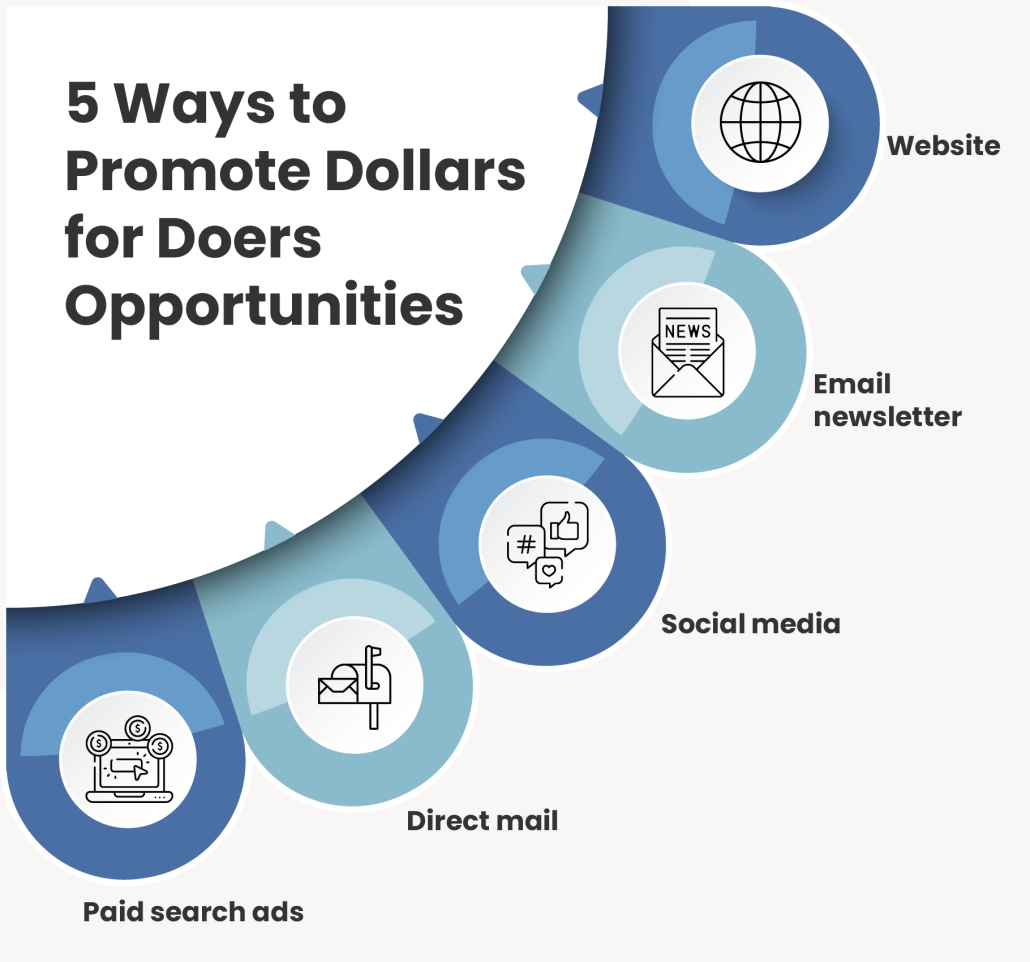
- Your website. Your website is the central location for everything supporters need to know about your nonprofit. Make sure you have a “Ways to Give” page that features Dollars for Doers so people can learn more about these types of programs.
- Email newsletter. If you already feature volunteer opportunities in your newsletter, try adding information about volunteer grants in that section. Explain that volunteers can work with their employers to contribute to your nonprofit at no additional cost to the volunteers themselves.
- Social media. Run a social media campaign dedicated to Dollars for Doers. Be sure to include photos of your volunteers in action and information on how to use your Dollars for Doers software solution.
- Direct mail. Sometimes, having a physical reminder of your nonprofit and its programs can inspire supporters to take action. The next time you send direct mail, include an insert about Dollars for Doers grants that links to the page on your website where you’ve embedded your Dollars for Doers tool.
- Paid search ads. Did you know that nonprofits can access $10,000 in free ad spending per month through the Google Ad Grants program? Once you’ve applied to the program and set up your account, you can leverage Google Ads to market Dollars for Doers opportunities and increase your reach to people outside your current supporter base.
By combining the power of corporate giving software with an effective marketing strategy, your nonprofit can truly maximize revenue from volunteer grants, earning more for your beneficiaries.
3 Organizations With Powerful Dollars for Doers Strategies
LLS’ Dollars for Doers Strategy
The Leukemia & Lymphoma Society (or LLS) employs a strategic approach to its Dollars for Doers program, which enhances volunteer engagement and fundraising alike.
LLS simplifies the process for volunteers by providing clear, step-by-step guidance on how to log their hours with their employers and submit the necessary documentation to secure the grants. This user-friendly approach encourages greater participation, helping to maximize the financial impact of each volunteer’s efforts.
And their strategy includes the following Volunteer Grants-dedicated landing page where supporters can access a wealth of information about the programs and how they can get involved. The page even includes an intuitive employer search tool where volunteers can quickly look up their company name to uncover program-specific guidelines and forms for requesting grant funds!
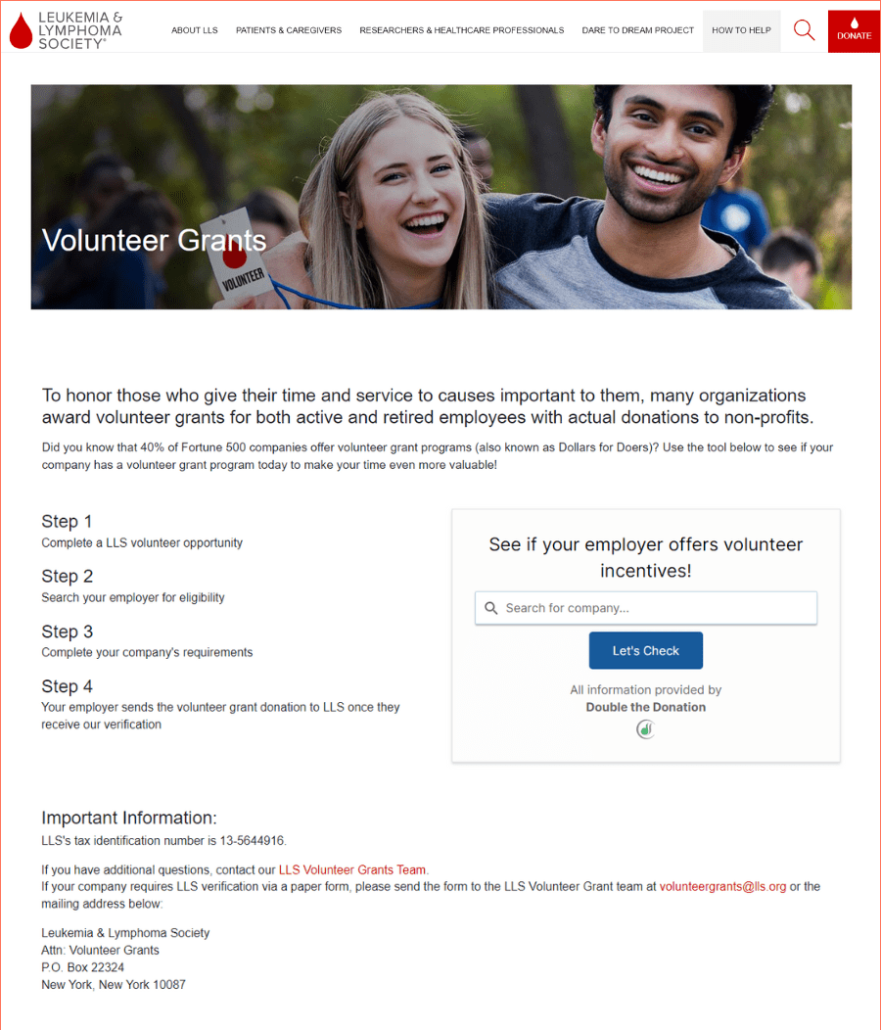
NFED’s Dollars for Doers Strategy
The National Foundation for Ectodermal Dysplasias (NFED) implements a “Dollars for Doers” strategy to enhance its fundraising efforts and deepen its engagement with supporters. This strategy involves partnering with companies that offer Individual Volunteer Grants, where employees’ volunteer hours translate into monetary donations to the nonprofit.
In order to promote the opportunity, NFED has crafted the following blog post on its website:
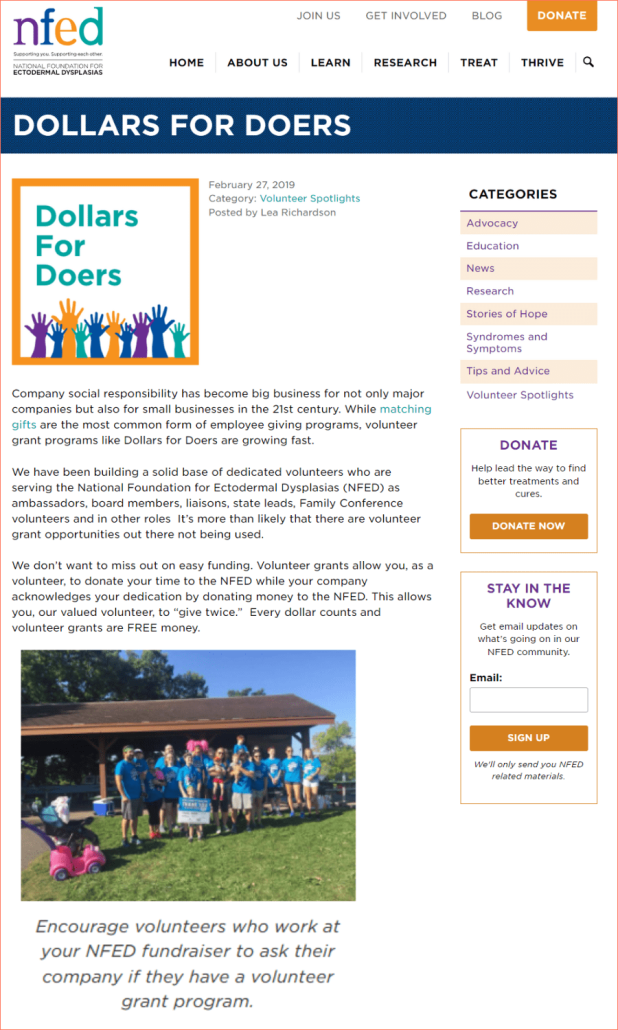
Play Like A Girl’s Dollars for Doers Strategy
Play Like a Girl’s Dollars for Doers strategy leverages corporate volunteerism by encouraging employees to convert their volunteer hours into financial donations through their employers’ volunteer grant programs.
The organization raises awareness among volunteers, providing guidance to streamline the process of logging hours and securing grants. And they provide educational resources, such as this blog post, to inform their audience about their opportunities to get involved. The blog even links out to their matching gifts page, which includes an embedded database search tool full of Dollars for Doers information, too!
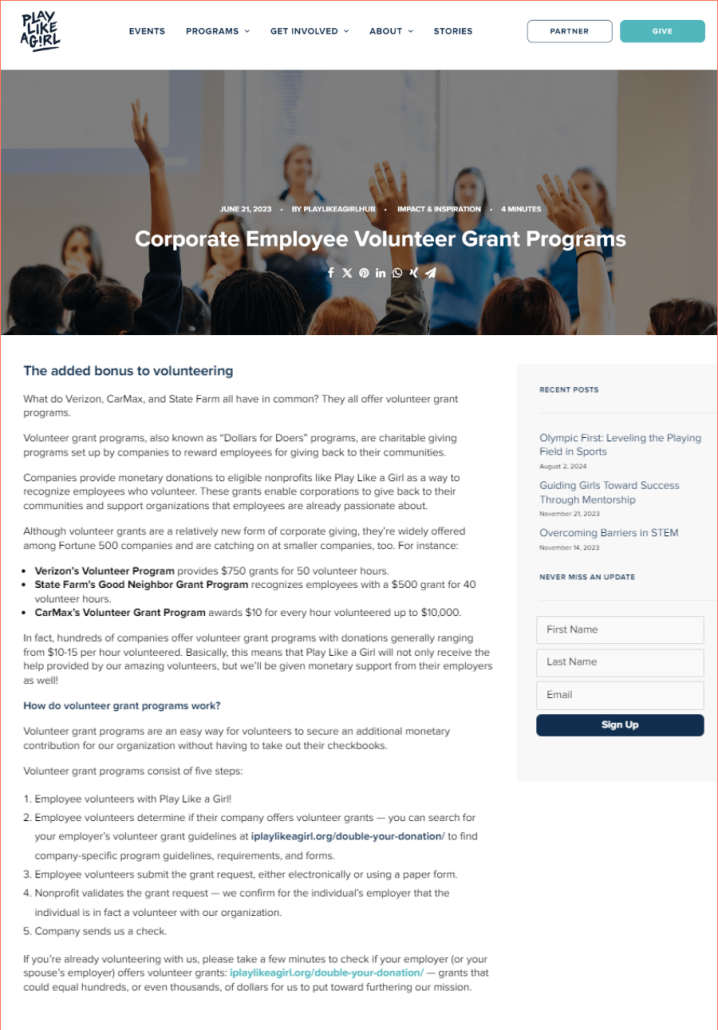
Additional Resources
Dollars for Doers programs are the ultimate corporate giving opportunity for nonprofits with a strong volunteer base. Not only can nonprofits incentivize volunteering, but they can also earn exponentially more for their causes.
Want to learn more about Dollars for Doers programs and how your team can take advantage of them? Check out the following resources:
- Corporate Volunteer Grants: The Basics & How to Secure Them. Dive deeper into Dollars for Doers grants, also called volunteer grants, with the help of this guide.
- Top 10 Volunteer Grant Companies: Increase Corporate Dollars. Wondering which companies are the best for volunteer grants? Check out this article to determine which businesses and supporters you should reach out to for more support.
- A Complete Guide to Volunteer Recruitment: 12 Key Strategies. Dollars for Doers grants aren’t possible without volunteers. Learn tips for how to recruit more volunteers and maximize revenue from corporate volunteer programs.
